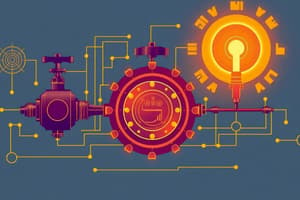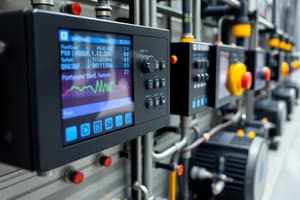Podcast
Questions and Answers
What are some examples of commonly measured process variables?
What are some examples of commonly measured process variables?
Temperature, Pressure, Flow rate, Level
Define feedback control in the context of process control.
Define feedback control in the context of process control.
Continuous measurement of a process variable and adjustment of input parameters based on the difference between actual and desired values.
Explain the difference between open loop and closed loop control systems.
Explain the difference between open loop and closed loop control systems.
Open loop systems do not incorporate feedback for error correction, while closed loop systems use feedback to correct errors and maintain stability.
What does a PID controller stand for and what are its components?
What does a PID controller stand for and what are its components?
How do PID controllers contribute to industrial process control?
How do PID controllers contribute to industrial process control?
What is the goal of control loops in process control?
What is the goal of control loops in process control?
What is the purpose of the proportional action in a control system?
What is the purpose of the proportional action in a control system?
How does integral action contribute to control systems?
How does integral action contribute to control systems?
Explain the role of derivative action in a control system.
Explain the role of derivative action in a control system.
What is the main focus of system dynamics in studying complex systems?
What is the main focus of system dynamics in studying complex systems?
How can engineers identify leverage points in system dynamics models?
How can engineers identify leverage points in system dynamics models?
Why are process variables, feedback control, control loops, PID controllers, and system dynamics crucial in designing process control systems?
Why are process variables, feedback control, control loops, PID controllers, and system dynamics crucial in designing process control systems?
Flashcards are hidden until you start studying
Study Notes
Process Control: An Overview of Key Concepts and Applications
This comprehensive article delves into various aspects of process control, focusing on key subtopics: process variables, feedback control, control loops, PID controllers, and system dynamics.
Process Variables
Process variables refer to the parameters within a process that require regulation to achieve specific outcomes. Commonly measured process variables include:
- Temperature
- Pressure
- Flow rate
- Level
Effectively managing these variables ensures optimal performance, reduces waste, minimizes downtime, and improves product quality.
Feedback Control
Feedback control involves continuous measurement of a process variable and adjustment of input parameters based on the difference between the actual and desired values, also known as the error. This iterative process aims to bring the process variable closer to the desired value, achieving stable and consistent performance.
Control Loops
Control loops represent a schematic representation of how changes in one part of a process affect another part, often with the goal of stabilizing the system. There are two main types: Open loop and Closed loop. In closed loop systems, feedback is incorporated to correct errors and maintain stability. The stability of a system is studied using Lyapunov's theorem.
PID Controllers (Proportional-Integral-Derivative)
PID controllers are the most common type of regulator used in industrial process control. They use a combination of proportional, integral, and derivative actions to control the process variable:
- Proportional Action: Adjusts the control action in proportion to the error. The larger the error, the larger the control action.
- Integral Action: Accumulates the error over time and adjusts the control action accordingly. This helps eliminate steady state error.
- Derivative Action: Predicts future behavior of the error based on its rate of change and adjusts the control action. This provides stability.
System Dynamics
System dynamics is a methodology for studying complex systems by focusing on feedback loops and stocks and flows within those systems. It has applications in many fields, including process control. System dynamic models can be simulated using software like STELLA or Vensim. By analyzing system dynamics, engineers can identify leverage points that allow them to improve system performance.
In conclusion, understanding these key concepts - process variables, feedback control, control loops, PID controllers, and system dynamics - is crucial for designing effective process control systems. These principles, when applied correctly, contribute significantly to maintaining efficiency, safety, and quality in industrial processes.
Studying That Suits You
Use AI to generate personalized quizzes and flashcards to suit your learning preferences.




